How to remove the OriginalModule unwanted application
Mac VirusAlso Known As: Ads by OriginalModule
Get free scan and check if your device is infected.
Remove it nowTo use full-featured product, you have to purchase a license for Combo Cleaner. Seven days free trial available. Combo Cleaner is owned and operated by RCS LT, the parent company of PCRisk.com.
What is OriginalModule?
People do not often download or install the OriginalModule app intentionally, since its installer is disguised as the Adobe Flash Player installer. Therefore, OriginalModule is categorized as a potentially unwanted application (PUA).
This app is designed to modify browser settings (to promote a fake search engine), generate advertisements, and collect browsing-related and possibly sensitive information. In this way, OriginalModule functions as adware and a browser hijacker.
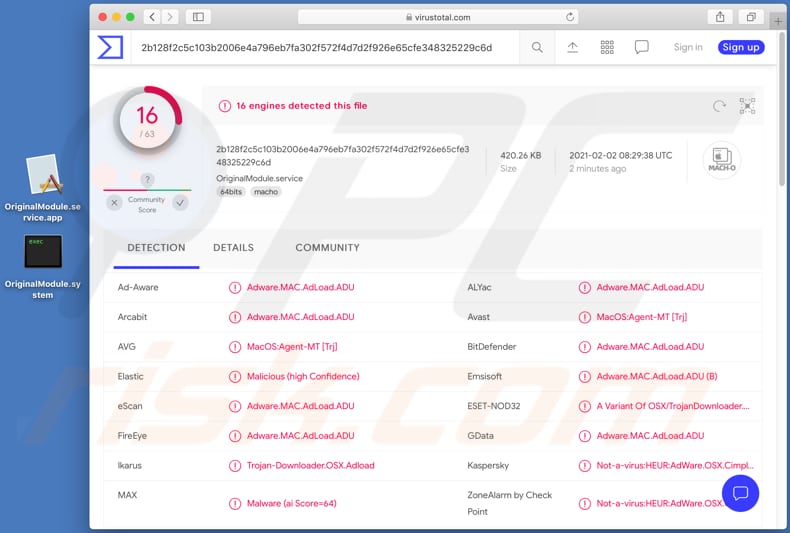
OriginalModule adware overview
Typically, adware generates revenue for its developer by displaying various pop-ups, coupons, banners, surveys, and other ads. It is not safe to click ads displayed by OriginalModule, since they can open dubious web pages or even download and install unwanted software.
OriginalModule app functions as a browser hijacker: it changes browser settings such as the default search engine, homepage, and new tab to the address of a fake search engine. Usually, fake search engines show results generated by other, legitimate search engines (such as Google, Bing, and Yahoo), however, they can also show results containing addresses of dubious, even malicious sites.
In most cases, users with browsers hijacked by apps such as OriginalModule can only remove fake search engines from browser settings when the app responsible is no longer installed.
OriginalModule also records data such as entered search queries, Internet Protocol addresses, geolocations, URLs of visited pages, and so on. These apps can also collect credit card details, passwords, and other sensitive information. The developers use the obtained information to generate revenue. For example, they might sell it to third parties (potentially, cyber criminals), misuse it to steal online accounts and identities, and for other malicious purposes.
| Name | Ads by OriginalModule |
| Threat Type | Adware, Mac malware, Mac virus |
| Detection Names (Deceptive Installer) | Avast (MacOS:Bundlore-DY [Adw]), BitDefender (Adware.MAC.Bundlore.EJD), Emsisoft (Adware.MAC.Bundlore.EJD (B)), Kaspersky (Not-a-virus:HEUR:AdWare.OSX.Bnodlero.ay), Full List (VirusTotal) |
| Detection Names (OriginalModule.service) | Avast (MacOS:Agent-MT [Trj]), BitDefender (Adware.MAC.AdLoad.ADU), ESET-NOD32 (A Variant Of OSX/TrojanDownloader.Adload.AE), Kaspersky (Not-a-virus:HEUR:AdWare.OSX.Cimpli.m), Full List (VirusTotal) |
| Detection Names (OriginalModule.system) | Avast (MacOS:Agent-MT [Trj]), BitDefender (Adware.MAC.AdLoad.ADV), ESET-NOD32 (A Variant Of OSX/TrojanDownloader.Adload.AE), Kaspersky (Not-a-virus:HEUR:AdWare.OSX.Cimpli.m), Full List (VirusTotal) |
| Additional Information | This application belongs to the Adload malware family. |
| Symptoms | Your Mac becomes slower than normal, you see unwanted pop-up ads, you are redirected to dubious websites. |
| Distribution methods | Deceptive pop-up ads, free software installers (bundling), fake Flash Player installers, torrent file downloads. |
| Damage | Internet browser tracking (potential privacy issues), display of unwanted ads, redirects to dubious websites, loss of private information. |
| Malware Removal (Windows) |
To eliminate possible malware infections, scan your computer with legitimate antivirus software. Our security researchers recommend using Combo Cleaner. Download Combo CleanerTo use full-featured product, you have to purchase a license for Combo Cleaner. 7 days free trial available. Combo Cleaner is owned and operated by RCS LT, the parent company of PCRisk.com. |
Adware examples
To summarize, apps such as OriginalModule are useless to regular users and can cause serious issues. Furthermore, computers and browsers with adware installed often run slower. In any case, adware is not trusted software and should be removed.
More adware examples are UpdaterSync, ProcessBrand, and CacheImprovment.
How did OriginalModule install on my computer?
OriginalModule is distributed using a fake Adobe Flash Player installer. These fake, third party installers can be malicious and are often designed to install ransomware, Trojan-type malware, and other malicious software.
PUAs are also distributed via download/installation set-ups of other products. This deceptive marketing tactic of packing regular software with unwanted or malicious additions is called "bundling".
Rushing download/installation processes (e.g. ignoring terms, skipping steps and settings, etc.) increases the risk of inadvertently allowing bundled content into the system.
Some PUAs have "official" download sites. Intrusive advertisements proliferate these applications as well. Once clicked, they can execute scripts to download/install PUAs without users' consent.
How to avoid installation of potentially unwanted applications
Download software and files from official websites and via direct links. It is not safe to use torrent clients, eMule (or other Peer-to-Peer networks), third party downloaders, unofficial websites or other sources of this kind.
Avoid third party installers. Check "Advanced", "Custom" and other settings, and decline offers to download or install unwanted software. Do not click ads that are displayed on dubious websites, since they can open other untrusted websites or even cause unwanted downloads and installations.
Remove any unwanted, suspicious applications (extensions, add-ons, and plug-ins) that are installed on the browser. The same should be applied to programs of this kind that are installed on the operating system.
Regularly scan your computer with reputable antivirus or anti-spyware software and keep this software up to date.
If your computer is already infected with OriginalModule, we recommend running a scan with Combo Cleaner Antivirus for Windows to automatically eliminate this adware.
Pop-up window displayed when OriginalModule adware is installed:
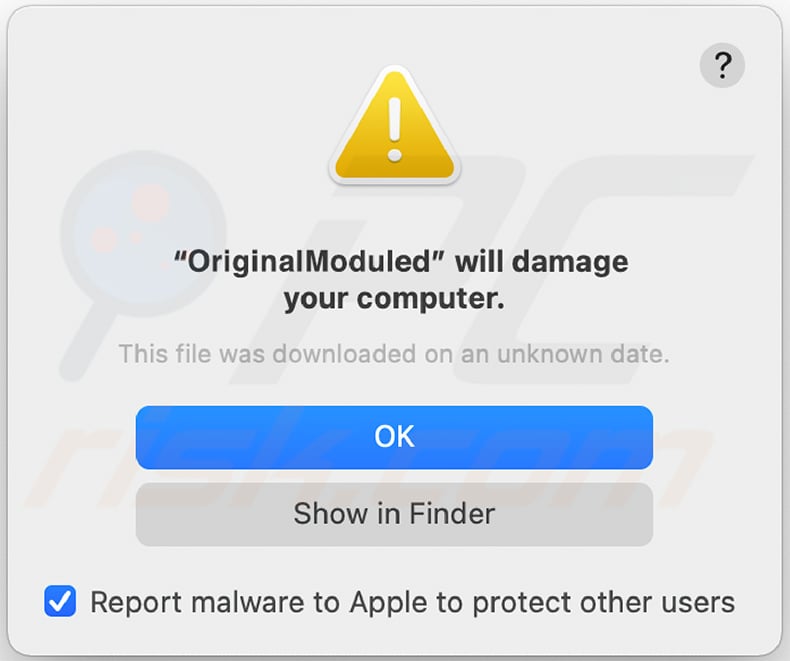
Text presented in this pop-up:
"OriginalModuled" will damage your computer.
This file was downloaded on an unknown date.
OK
Show in Finder
Screenshot of the deceptive installer used to distribute OriginalModule adware (first installation step):
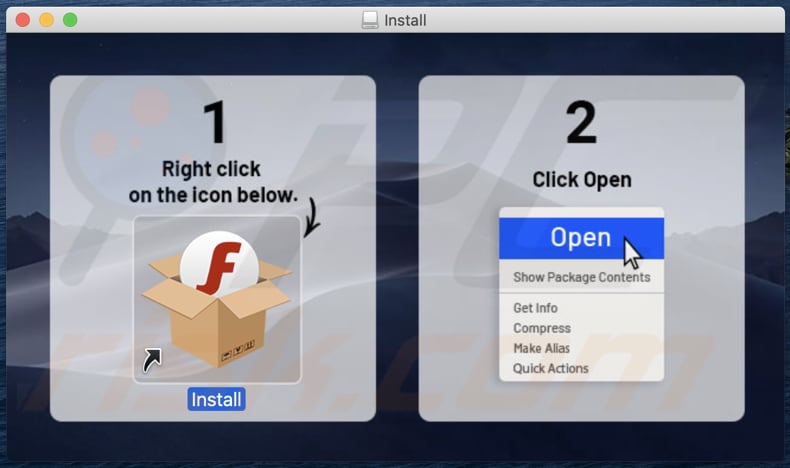
Screenshot of the deceptive installer used to distribute OriginalModule adware (second installation step):
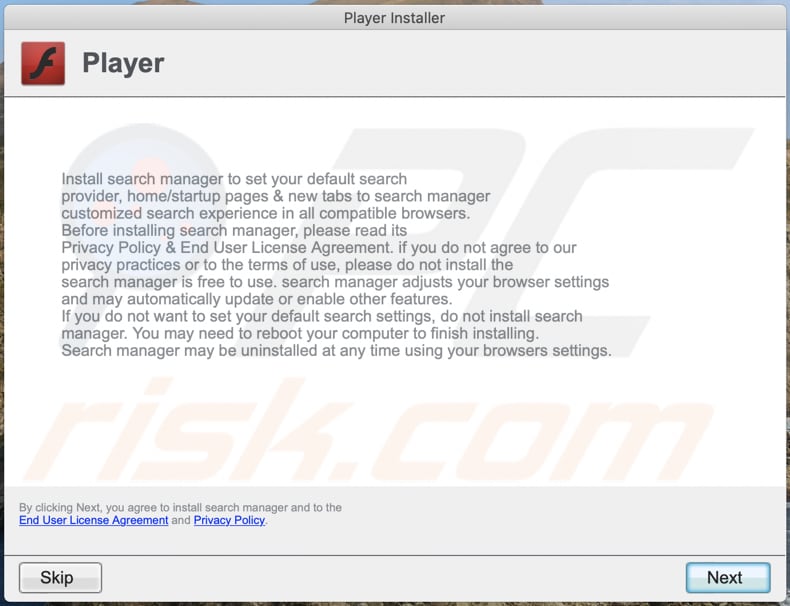
Files related to the OriginalModule adware that need to be removed:
- /Library/LaunchDaemons/com.OriginalModule.system.plist
- /Library/Application Support/.[random_string]/System/com.OriginalModule.system/OriginalModule.system
- ~/Library/LaunchAgents/com.OriginalModule.service.plist
- ~/Library/Application Support/.[random_string]/Services/com.OriginalModule.service/OriginalModule.service
IMPORTANT NOTE! In some cases, malicious OriginalModule like OriginalModule alter system proxy settings, thereby causing unwanted redirects to a variety of dubious websites.
The redirects are likely to remain even after removing the application itself. Thus, you must restore them manually.
Step 1: Click on the gear icon in the Dock to navigate to the system settings. If the icon is not present in the Dock, you can find it in the Launchpad.
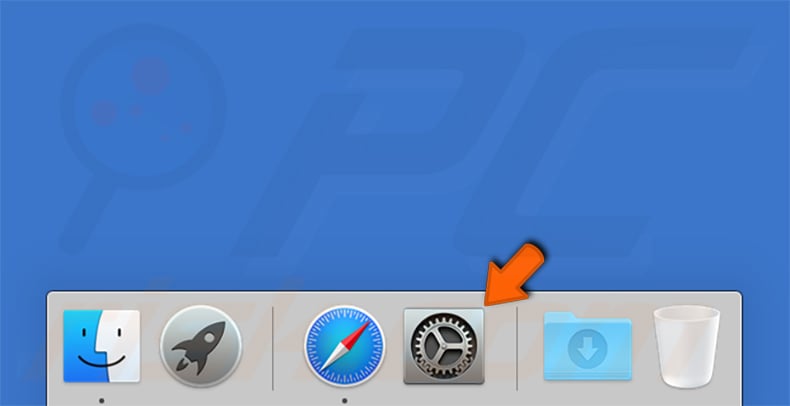
Step 2: Navigate to the Network settings.
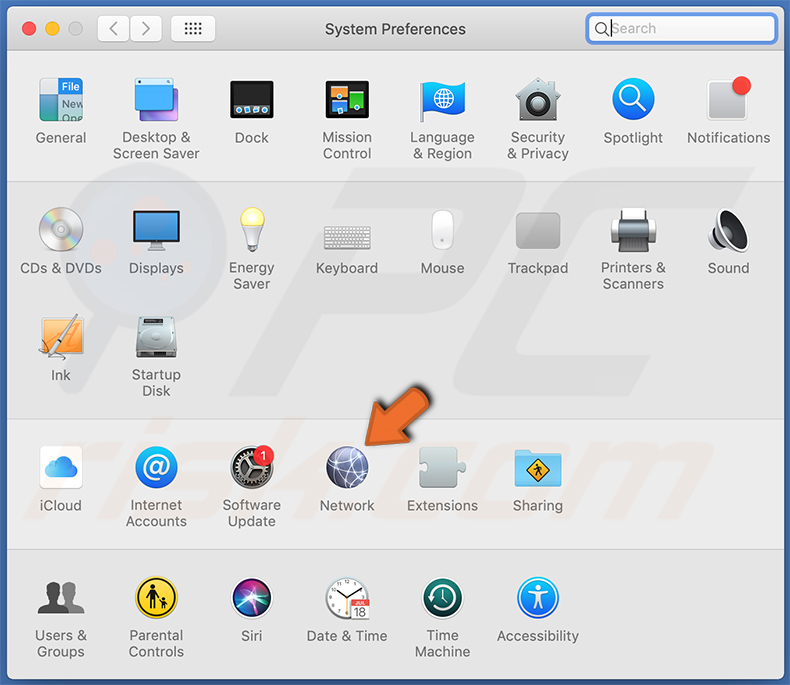
Step 3: Select the connected network and click "Advanced...".
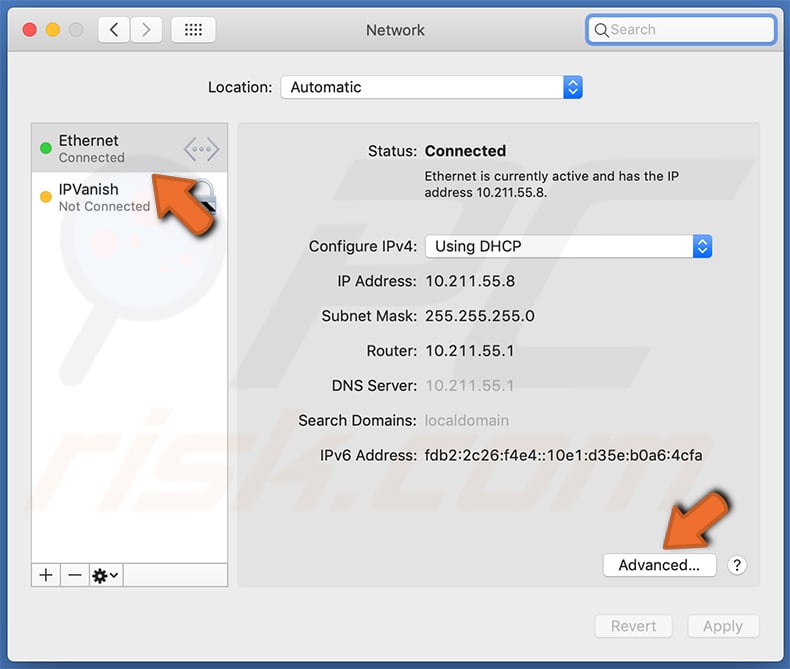
Step 4: Click on the "Proxies" tab and untick all the protocols. You should also assign the settings of each protocol to the default: "*.local, 169.254/16".
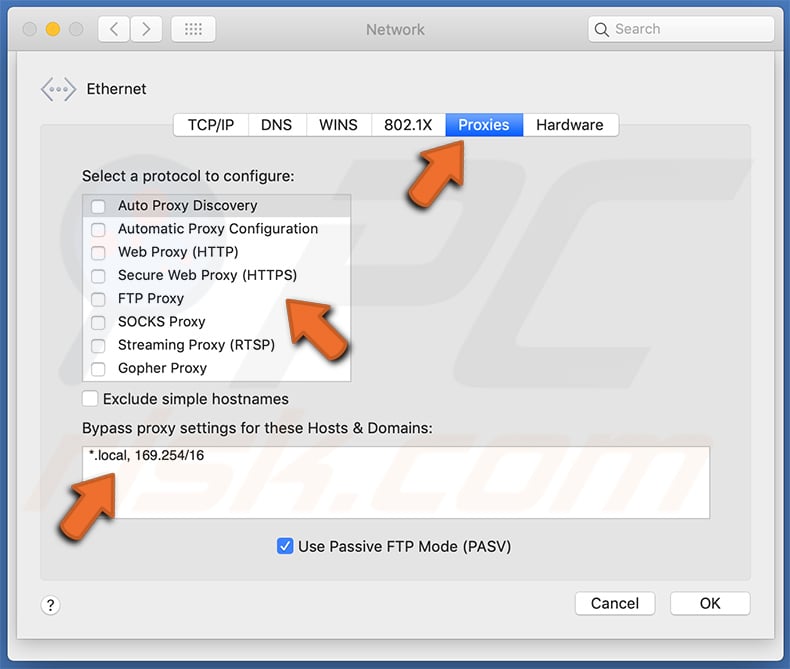
Instant automatic malware removal:
Manual threat removal might be a lengthy and complicated process that requires advanced IT skills. Combo Cleaner is a professional automatic malware removal tool that is recommended to get rid of malware. Download it by clicking the button below:
DOWNLOAD Combo CleanerBy downloading any software listed on this website you agree to our Privacy Policy and Terms of Use. To use full-featured product, you have to purchase a license for Combo Cleaner. 7 days free trial available. Combo Cleaner is owned and operated by RCS LT, the parent company of PCRisk.com.
Quick menu:
- What is OriginalModule?
- STEP 1. Remove OriginalModule related files and folders from OSX.
- STEP 2. Remove OriginalModule ads from Safari.
- STEP 3. Remove OriginalModule adware from Google Chrome.
- STEP 4. Remove OriginalModule ads from Mozilla Firefox.
Video showing how to remove OriginalModule adware using Combo Cleaner:
OriginalModule adware removal:
Remove OriginalModule-related potentially unwanted applications from your "Applications" folder:

Click the Finder icon. In the Finder window, select "Applications". In the applications folder, look for "MPlayerX", "NicePlayer", or other suspicious applications and drag them to the Trash. After removing the potentially unwanted application(s) that cause online ads, scan your Mac for any remaining unwanted components.
DOWNLOAD remover for malware infections
Combo Cleaner checks if your computer is infected with malware. To use full-featured product, you have to purchase a license for Combo Cleaner. 7 days free trial available. Combo Cleaner is owned and operated by RCS LT, the parent company of PCRisk.com.
Remove adware-related files and folders

Click the Finder icon, from the menu bar. Choose Go, and click Go to Folder...
 Check for adware generated files in the /Library/LaunchAgents/ folder:
Check for adware generated files in the /Library/LaunchAgents/ folder:

In the Go to Folder... bar, type: /Library/LaunchAgents/

In the "LaunchAgents" folder, look for any recently-added suspicious files and move them to the Trash. Examples of files generated by adware - "installmac.AppRemoval.plist", "myppes.download.plist", "mykotlerino.ltvbit.plist", "kuklorest.update.plist", etc. Adware commonly installs several files with the exact same string.
 Check for adware generated files in the ~/Library/Application Support/ folder:
Check for adware generated files in the ~/Library/Application Support/ folder:

In the Go to Folder... bar, type: ~/Library/Application Support/

In the "Application Support" folder, look for any recently-added suspicious folders. For example, "MplayerX" or "NicePlayer", and move these folders to the Trash.
 Check for adware generated files in the ~/Library/LaunchAgents/ folder:
Check for adware generated files in the ~/Library/LaunchAgents/ folder:

In the Go to Folder... bar, type: ~/Library/LaunchAgents/

In the "LaunchAgents" folder, look for any recently-added suspicious files and move them to the Trash. Examples of files generated by adware - "installmac.AppRemoval.plist", "myppes.download.plist", "mykotlerino.ltvbit.plist", "kuklorest.update.plist", etc. Adware commonly installs several files with the exact same string.
 Check for adware generated files in the /Library/LaunchDaemons/ folder:
Check for adware generated files in the /Library/LaunchDaemons/ folder:

In the "Go to Folder..." bar, type: /Library/LaunchDaemons/

In the "LaunchDaemons" folder, look for recently-added suspicious files. For example "com.aoudad.net-preferences.plist", "com.myppes.net-preferences.plist", "com.kuklorest.net-preferences.plist", "com.avickUpd.plist", etc., and move them to the Trash.
 Scan your Mac with Combo Cleaner:
Scan your Mac with Combo Cleaner:
If you have followed all the steps correctly, your Mac should be clean of infections. To ensure your system is not infected, run a scan with Combo Cleaner Antivirus. Download it HERE. After downloading the file, double click combocleaner.dmg installer. In the opened window, drag and drop the Combo Cleaner icon on top of the Applications icon. Now open your launchpad and click on the Combo Cleaner icon. Wait until Combo Cleaner updates its virus definition database and click the "Start Combo Scan" button.

Combo Cleaner will scan your Mac for malware infections. If the antivirus scan displays "no threats found" - this means that you can continue with the removal guide; otherwise, it's recommended to remove any found infections before continuing.

After removing files and folders generated by the adware, continue to remove rogue extensions from your Internet browsers.
Remove malicious extensions from Internet browsers
 Remove malicious Safari extensions:
Remove malicious Safari extensions:

Open the Safari browser, from the menu bar, select "Safari" and click "Preferences...".

In the preferences window, select "Extensions" and look for any recently-installed suspicious extensions. When located, click the "Uninstall" button next to it/them. Note that you can safely uninstall all extensions from your Safari browser - none are crucial for regular browser operation.
- If you continue to have problems with browser redirects and unwanted advertisements - Reset Safari.
 Remove malicious extensions from Google Chrome:
Remove malicious extensions from Google Chrome:

Click the Chrome menu icon ![]() (at the top right corner of Google Chrome), select "More Tools" and click "Extensions". Locate all recently-installed suspicious extensions, select these entries and click "Remove".
(at the top right corner of Google Chrome), select "More Tools" and click "Extensions". Locate all recently-installed suspicious extensions, select these entries and click "Remove".

- If you continue to have problems with browser redirects and unwanted advertisements - Reset Google Chrome.
 Remove malicious extensions from Mozilla Firefox:
Remove malicious extensions from Mozilla Firefox:

Click the Firefox menu ![]() (at the top right corner of the main window) and select "Add-ons and themes". Click "Extensions", in the opened window locate all recently-installed suspicious extensions, click on the three dots and then click "Remove".
(at the top right corner of the main window) and select "Add-ons and themes". Click "Extensions", in the opened window locate all recently-installed suspicious extensions, click on the three dots and then click "Remove".

- If you continue to have problems with browser redirects and unwanted advertisements - Reset Mozilla Firefox.
Frequently Asked Questions (FAQ)
What harm can adware cause?
Adware can diminish the browsing experience and system performance. Advertising-supported software displays ads that may promote content capable of causing serious problems (e.g., system infections, privacy issues, financial losses, etc.). Furthermore, this software is classed as a privacy threat, as it typically has data-tracking functionalities.
What does adware do?
Adware is designed to deliver intrusive advertisement campaigns. It displays ads on various interfaces. Additionally, some types can force-open sites and gather private information.
How do adware developers generate revenue?
Adware developers generate revenue mainly via affiliate programs by endorsing websites, apps, extensions, products, services, etc.
Will Combo Cleaner remove OriginalModule adware?
Yes, Combo Cleaner will scan your system and eliminate detected adware-type apps. It is noteworthy that manual removal (performed without security tools) might not be ideal. In some cases, after the adware has been manually removed – file leftovers can stay hidden within the system. What is more, the remaining components might continue to run and cause issues. Therefore, it is essential to eliminate advertising-supported software thoroughly.
Share:

Tomas Meskauskas
Expert security researcher, professional malware analyst
I am passionate about computer security and technology. I have an experience of over 10 years working in various companies related to computer technical issue solving and Internet security. I have been working as an author and editor for pcrisk.com since 2010. Follow me on Twitter and LinkedIn to stay informed about the latest online security threats.
PCrisk security portal is brought by a company RCS LT.
Joined forces of security researchers help educate computer users about the latest online security threats. More information about the company RCS LT.
Our malware removal guides are free. However, if you want to support us you can send us a donation.
DonatePCrisk security portal is brought by a company RCS LT.
Joined forces of security researchers help educate computer users about the latest online security threats. More information about the company RCS LT.
Our malware removal guides are free. However, if you want to support us you can send us a donation.
Donate
▼ Show Discussion